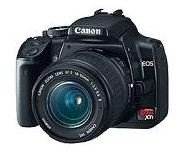Canon EOS Digital Rebel XTi - DSLR Camera Review & Buying Guide
Canon EOS Rebel XTi Overview and Features
The Canon EOS Rebel XTi, known as the EOS 400D in Europe, was first released in 2006. The camera uses Canon’s popular EOS, Electro-Optical System, line of lenses. The XTi, like most of Canon’s current digital cameras is compatible with EF and EF-S style lenses. These are the same lenses used on higher end Canon Digital Cameras. This allows the owner to not only use a wide range of Canon lenses ranging from zoom lenses, to macro lenses, to image-stabilizing lenses, to fish-eye lenses, but also provides a way for that investment to be carried forward if the photographer chooses to upgrade to a higher-level model at a later date.
The Canon XTi has impressive specifications. It has 10.1 effective megapixels, a 2.5 inch LCD display, an autofocus system that uses 9 points, and a self-cleaning system to keep dust off of the sensor. In burst mode, the XTi can take up to 3 frames-per-second. However to get that number, the shots must be taken at 1/250 or faster.
Canon Rebel XTi Review Beyond The Specs (4 out of 5)

The Rebel XTi makes a great camera for the serious amateur or the beginning professional. The XTi, has many of the same features of more expensive models, including full manual control, aperture priority mode, shutter speed priority mode, and macro mode. As mentioned, it accepts a wide variety of Canon and third-party camera lenses. It also accepts Canon’s popular Speedlight line of external flashes for better lighting and the ability for bouncing the flash.
A good home studio setup paired with the XTi can produce some great portrait style photographs. The camera really shines with the right lighting, a still subject, and a tripod mount. Under these conditions, the camera can take crystal clear shots capable of poster size printing with no noticeable noise.
The Rebel XTi can take shots at up to 1600 ISO, but does much better below 800. Since the speed is dependent upon the lens, upgrading to a better lens allows the photographer to work well within the camera’s comfort range.
One of the Rebel’s strengths is its light weight. With a small lens, an XTi can be supported by a Gorrilla Tripod or other mini-tripod. Coupled with the built-in timer, or separately available remote, this allows the camera to be used for taking family portraits with photographer mom, or photographer dad actually in the shot.
It’s small size also means that it doesn’t take a large camera bag to lug it around either for picture hunting, or for taking shots of the family at the zoo, the amusement park, or just the playground.
The main drawbacks to the XTi, other than the lower megapixel count and non-full frame sensor, involve shooting fast. Taking pictures in burst mode while using the flash tends to work for 3 or 4 shots and then the limiting factor becomes how quickly the flash can fire again. When using an external flash, the recharge time is dependent upon the batteries in the flash with newer fully charged batteries allowing pretty quick shots and batteries with a lower charge slowing the whole thing down to a crawl.
Even when not shooting in burst mode, the camera can take too long to focus, especially with moving subject that are close, particularly if using a zoom lens. Imagine dad shooting a waterfall at Yellowstone park and then turning around to see the kids doing something great and then trying to get the shot, and you have an idea of where it lags a bit.
However, in the end, most of the XTi’s potential shortcomings are unlikely to prove detrimental to anyone but the high-end professional photographer.